Of all the Italian provinces, perhaps none is more famous the world over than Tuscany. Full of rolling hills, medieval villages and vineyards, Tuscany is what European dreams are made of. But while Florence might be one of the most famous cities on the planet, this post is going to focus on its less famous counterpart, Siena, and the Chianti region wineries between the two cities.
Siena is arguably the most beautiful Tuscan city and where you should base yourself on a trip to central Tuscany. From Siena you can explore the famous Chianti region wineries, where Chianti Classico and other delicious red wines come from. This post will go through all the best things to do in the region, so read on to see why you should be booking your trip to Siena now!
Note: this article contains affiliate links, which means that should you purchase something or get a quote through them I may make a small commission at no additional cost to you. This helps keep the site running with up to date information. I do not represent World Nomads, Booking.com, GetYourGuide, Manawa, or discovercars.com. This is information only and not a recommendation to buy the product mentioned in this article.
Siena and Chianti – What You Need to Know
Where is Siena?
Siena is a medieval Italian city known for its picturesque, narrow streets and legendary horse races around the main plaza. The Chianti region is Italy’s most famous and well known wine region, known mainly for Chianti Classico, a rich red wine only made in the region.
Siena is in central Italy, about an hour’s drive south of Florence and about 4 hours south of Genoa. Between the two cities lies the Chianti wine region, famous for its red wine, rolling hills and long driveways lined with cypress trees.
How to get to Siena and the Chianti Region Wineries
There is no major airport in Tuscany. Pisa and Florence both have airports that are well connected to the rest of Europe though. If you’re coming from overseas it might be fastest to fly direct to Rome. Either way, you’ll have to take the train to Siena or rent a car.
Once you’re there the city is so small that even if you’re staying outside of the city walls it’s possible to explore everything on foot. There are a number of hotels in Siena just outside the city center that offer parking, and rental cars in Italy are cheap (though note that all Italian highways are toll roads and petrol is expensive so be sure to check out my guide to driving in Europe before planning a road trip).
To get to the world famous Chianti region wineries without a tour, however, you will need a car. Though if you don’t want to drive yourself, you can always hire a driver. It will cost a few hundred Euro extra, but could be very well worth it. A good company to use for this service is We Drive You Tuscany.
If you decide to drive yourself, for the best deals on rental cars in Italy we use Discovercars.com. You can book your rental in Italy for a great rate using the link below.
Click here to find a great rate on a rental car in Italy!
When to visit Siena the Chianti Region
For the best weather and when to avoid Italian tourists on summer holiday May, June, September and October are your best bet, just like anywhere else in Italy. I’ve been in October and in November and the difference was stark.
Mid October was amazing. Warm enough to go to the pool and wear a T-shirt at night, completely sunny, while late November was pretty cold and relatively cloudy. For the absolute best weather while still avoiding the peak tourist season, consider visiting Tuscany in September. Do note, however, that in 2023 and 2024 central Italy has had a lot of rain in October. Who knows if that trend will remain, though.
Where to stay in Siena
I suggest staying in Siena, either right in the middle of the city or right outside the walls if you have a car. There are hotels with parking inside the walls, but the city roads are super narrow and steep and I’d recommend not trying to drive them. I stayed at Hotel Santa Caterina Siena outside the city walls and had a nice stay. However, for the absolute best view of the city I’d stay in Hotel Almadomus if I go again.
If either of those hotels doesn’t float your boat then you can find another lovely hotel in Siena here.
How long to spend in the region
You could spend weeks in this region and not get bored. You’ll probably come to Siena as part of a longer road trip around Tuscany. The city is small and can be easily seen in one day. But for a better experience including Chianti and the surrounding region stay at least two days. Three or four days would be ideal to hit all of the highlights mentioned in this article and get a night in Florence to top it off.
Language
You’ll get by fine without knowing any Italian, even though many locals won’t speak more than a few words of English. This region is accustomed to American visitors. But at least learn how to say thank you: grazie.
Food
Tuscany is known for quite a few culinary creations, though nothing that seems to have caught wave internationally. For the local pasta, try pici. It’s a thick spaghetti noodle. My favorite is to have it with wild boar ragu.
Tuscany is also famous for the Florentine steak, a thick cut of sirloin made from local steer and served too rare for me. There are endless opportunities to devour amazing food on your trip to Siena and Chianti.
Money
Italy uses the euro. You shouldn’t need cash but carry at least some. Siena is reasonably priced, probably mid-range for an Italian destination. The Chianti region is pricey though. You can reasonably expect to pay at least 20 euros for a wine tasting and tour and 50 euros for lunch with wine tasting at a vineyard.
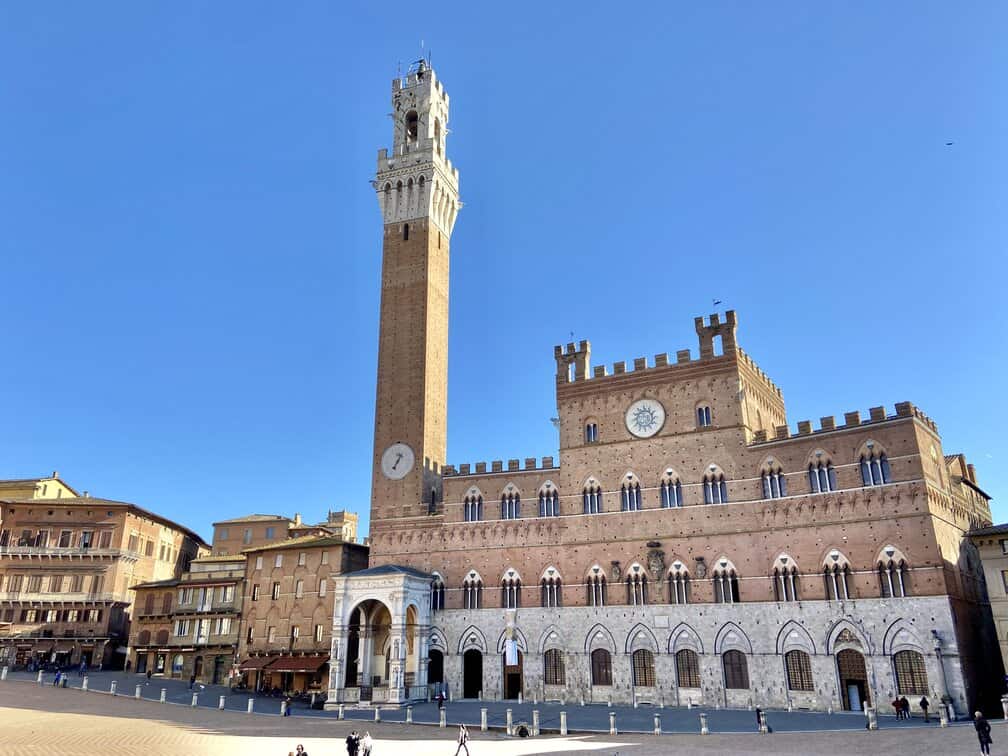
Americans tourists everywhere
One thing about Tuscany is that it is loaded with American tourists. This is one of many reasons why I prefer Siena over Florence. While you’ll hear plenty of Americans in Siena, it’s nothing compared to Florence, where every other voice you hear on the street is American.
The Chianti region wineries are also loaded with Americans looking for the best Italian wine. If you’re looking for a vacation to avoid Americans, this is not it.
Travel insurance
Before visiting Italy, you’ll want to consider purchasing travel insurance so that you’re protected for the unexpected. We use World Nomads when we travel abroad. World Nomads provides coverage to travelers in over 100 countries. You can search for a coverage plan using the link below.
The City of Siena
In central Tuscany lies the beautiful medieval city of Siena. Siena is without a doubt one of the most picturesque cities in Europe. I chose to spend longer here than Florence when planning my trip and I was super happy that I did.
Not that I didn’t like Florence. It just had too many Americans and it was full of designer shops and overpriced, terrible restaurants. Siena was more “real Italy” to me. There were no streets of fancy brand name stores and it wasn’t overly crowded with tourists.

The city is surrounded by a medieval wall, but unlike many ancient city walls in Europe, this one cannot be walked on. It’s too thin. There are a few gates that open the wall to vehicle and foot traffic. Inside the walls the city is very hilly. It’s hard to find a flat street.
The streets themselves are narrow and usually lined with 5-7 story buildings that might have retail or a restaurant at the ground floor and apartments above. There is one main plaza and a few cathedrals that serve as your main landmarks for getting around.
Walking around Siena is an experience in itself. The streets are so charming you don’t want to stop exploring. I tried to turn down every street to see what was there, even if it was just apartments. Give yourself at least four hours to just walk around, making sure to hit the key spots given here in the next section.
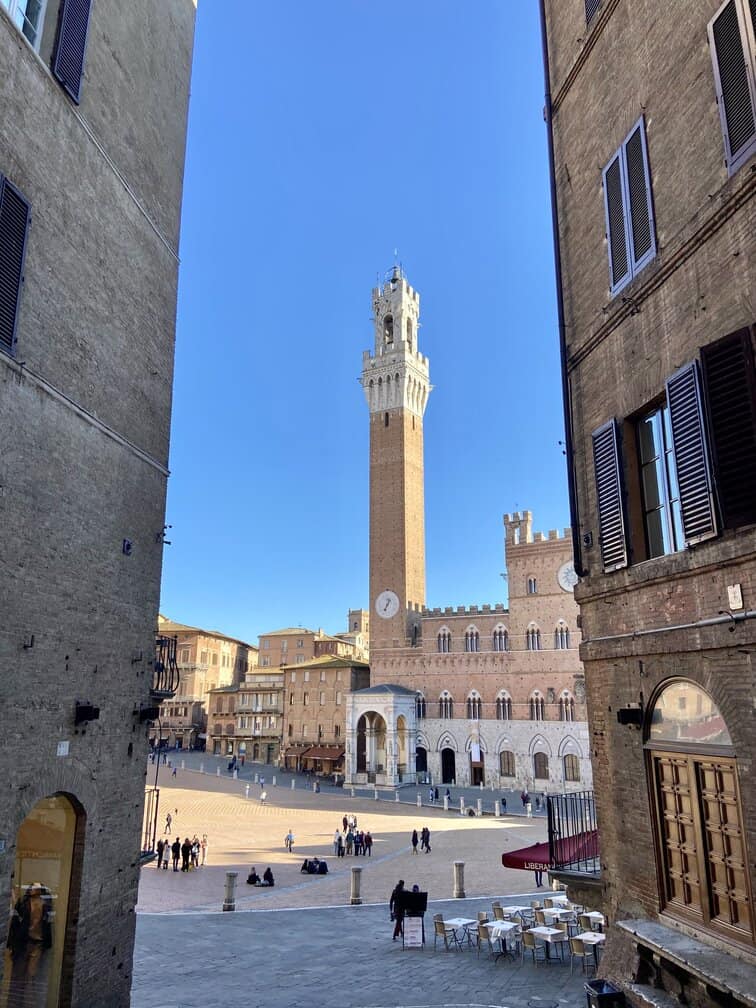
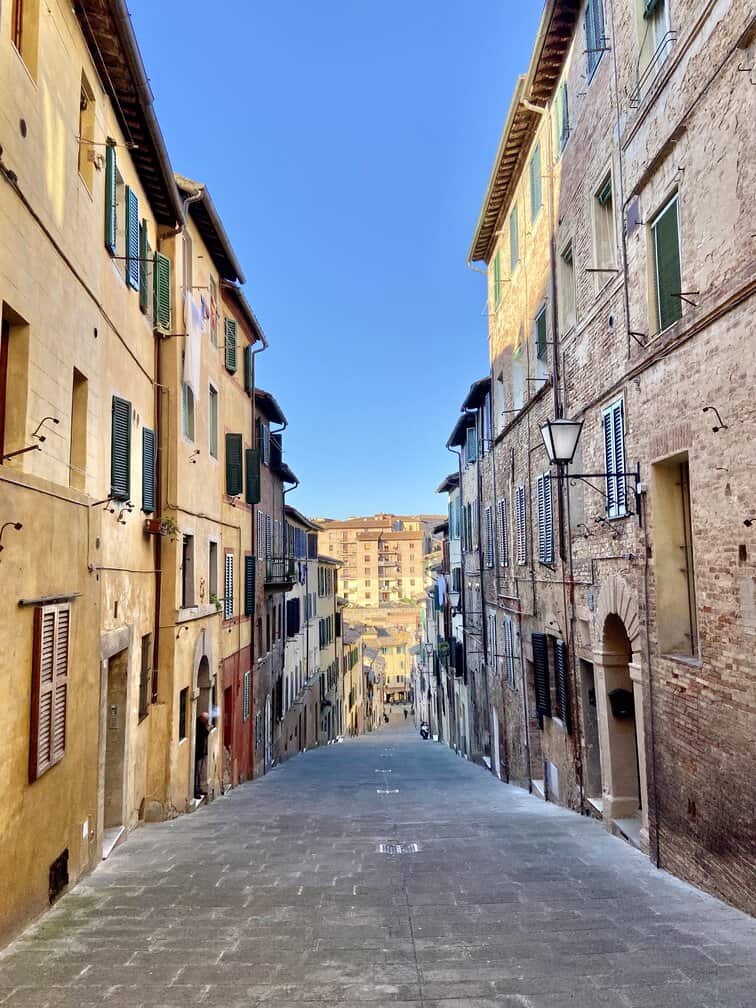
What not to miss in Siena
- Piazza del Campo: This is the main plaza. It’s huge and it slopes towards the town hall in all directions (nothing in the city is flat). Across from the town hall the plaza is lined with restaurants and cafes. Note that these are by far the most expensive restaurants in the city. You’re paying for the view.
- Torre de Mangia: This tower is part of the town hall building. It was built in the 1300s and rises 87m over the city below. It’s 10 EUR to climb the stairs to the top for an incredible view of Siena and the surrounding Tuscan countryside. If you spend money on one thing in Siena, spend it here.
- Duomo di Siena: The main cathedral for the city sits atop a hill, the highest point in Siena. Built in the 1200s and clad with black and white marble, it looks similar to the large cathedrals in Florence, just a bit smaller. You can also go to the top of the building for a nice city view if you pay extra.
- Via Camporegio: For the best view of the city, head over to this little street and duck through the bushes behind the line of parked cars. There are some openings in the bushes that spit you out on a steep hill. From the top of that hill the view of the city is stunning. Click the link I’ve provided here for the exact location.
- Via del Comune: This is probably the steepest street in Siena and it’s lined with beautiful, colorful houses on each side. The street is closed to vehicles so you can enjoy it properly.
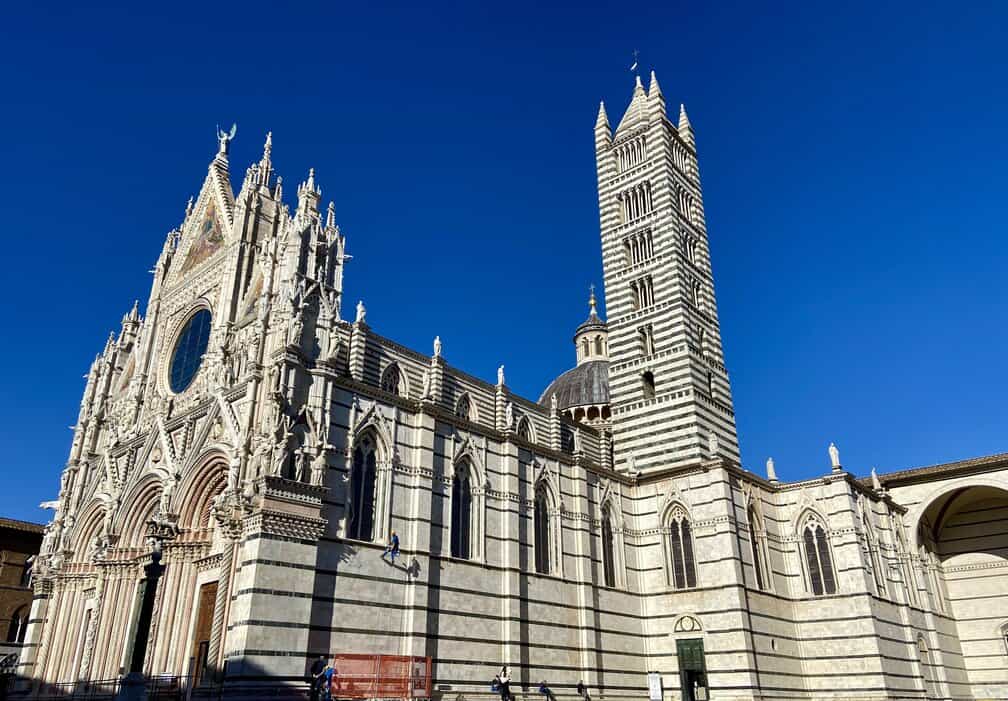
Stops to make if there is time
- Fontebranda: A 13th century fountain covered in gothic brick arches.
- Basilica Cateriniana San Domingo: Not the most flattering church from the outside, but beautiful nonetheless.
- Fortress Medicea: Literally a giant old fortress that is now a public park. Nice view of the countryside from the fortress walls.
- Museo Archeologico Nazionale (National Archeological Museum): small museum dedicated to archeological findings in the region.
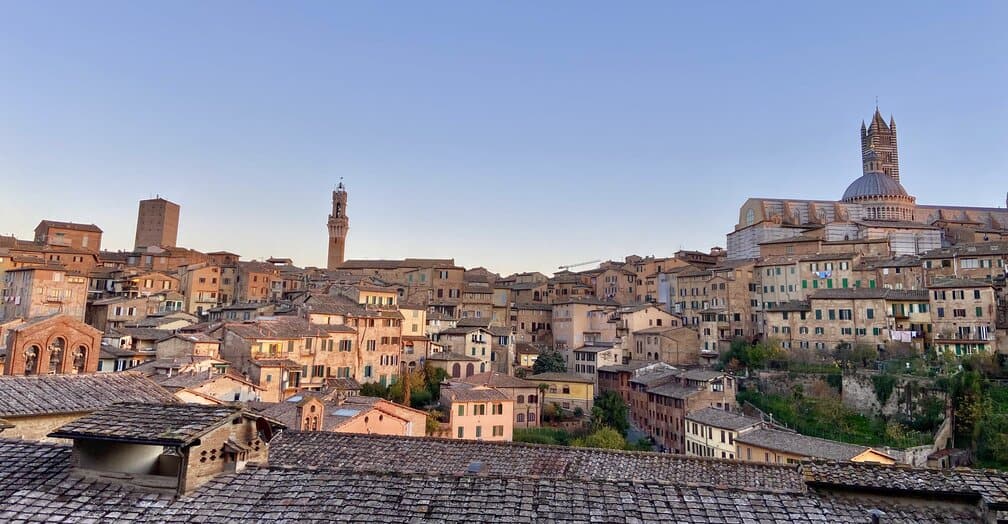
If you prefer to explore Siena with a knowledgeable local guide, there are tons of city tours available. You can check out all the tour options in Siena and book your guided city tour here or you can check out some additional tours from Siena below.
Where to eat in Siena
I did quite a lot of research on where to eat and ended up choosing a place I wasn’t too happy with. But here are few of the top reviewed restaurants in the city. Most of these give you an experience of eating in a vaulted brick cellar. You should book these in advance.
If you’re just in the mood for pizza head to Pizzeria Alle Scalette. If local wine is all you’re looking for then check out Trefilari Wine Bar, where the wine menu is 80 pages long (mostly Tuscan wines). Speaking of wine, read on for how to experience one of the world’s most famous wine regions!
Chianti Region Wine and Wineries
There are few places in the world that are as synonymous with wine as Tuscany is. Burgundy, France or Napa Valley, California maybe. But it’s hard to argue against Tuscany when it comes to wine.
There are wineries all over Tuscany, but the most famous region is Chianti, which lies between Florence and Siena. Chianti Classico can only come from this region. And let me tell you, that wine is frikin’ delicious!

Wine is integral in Tuscan culture. Many people here drink it every day for lunch and dinner. Unless you don’t drink, it’s not really a trip to Tuscany without visiting a vineyard. There are thousands of wineries scattered across the Chianti region.
Everything from small family-run establishments to commercial wineries mass producing wine for shipment around the world. In this section I’ll try to explain a little about the Chianti region wineries.
Chianti Classico
Chianti Classico is a rich red wine made primarily from the Sangiovese grape variety. The “Classico” part of the name doesn’t really refer to any classic way of making the wine, but of a particular part of the Chianti region where the grapes are grown. Grapes grown outside of that region can be Chianti, but not Chianti Classico.
Chianti Classico has been in production for about 300 years and it is the main type of wine you will see and taste on your wine tour through Chianti. When the “Reserve” label is added on the end, it means the wine was aged at least two years in a barrel prior to bottling.
While Chianti is mostly known for Chianti Classico, it’s not the only wine you’ll try in the region. There are many other varieties, including roses and whites as well as reds with other mixtures of grape varieties. Whatever you try, it’s bound to be delicious.
Visiting the Chianti Region wineries
Now for the fun part – visiting the wineries! You used to be able to just show up to wineries in Tuscany unannounced and do some wine tasting. The covid-19 pandemic put an end to that though, and it seems the change is here to stay.
Before visiting any vineyard you must make prior arrangements. Many tours can be booked online. If a winery doesn’t have an online booking form you can email or call to set something up.
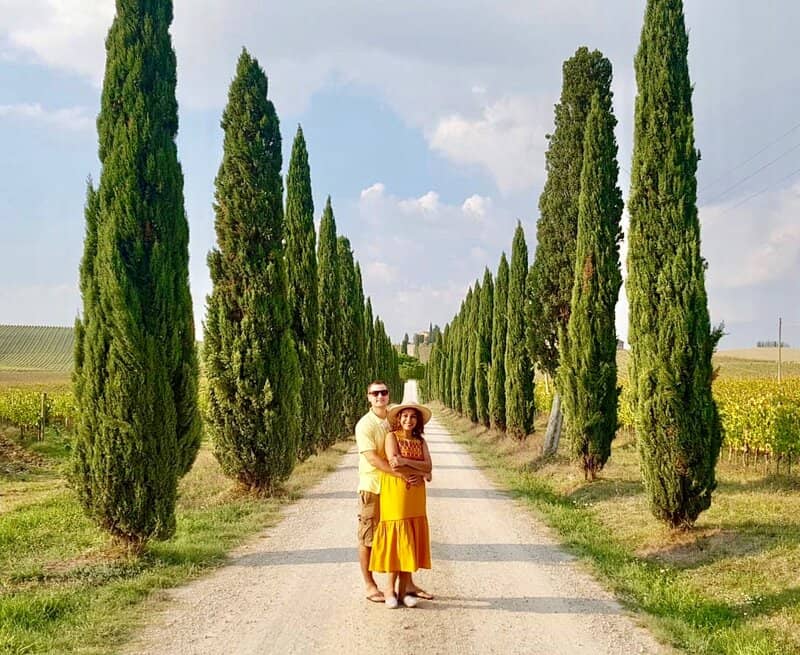
The Chianti region wineries are typically open from 10-6, though it varies depending on the establishment and season. Most of the more formidable ones have restaurants and serve epic lunches. It’s not uncommon to spend 3 hours at lunch trying various wines and olive oils and balsamic vinegars. You’ll be enjoying yourself so much that you’ll lose track of time!
Note that in the off-season (Nov-April) many of the vineyards are closed or have reduced hours. A lot stay open, but your choices will be more limited than if you visit May-Oct.
Castles and Villas
One of the coolest things about Tuscany is that many of the wineries are actually old medieval castles, often run by the same family for hundreds of years. Not only does this add some cool history to the wineries, but the castles are all beautiful properties. Well manicured gardens and stone masonry walls are a common site, almost as common as a long, dirt driveway lined with cypress trees.
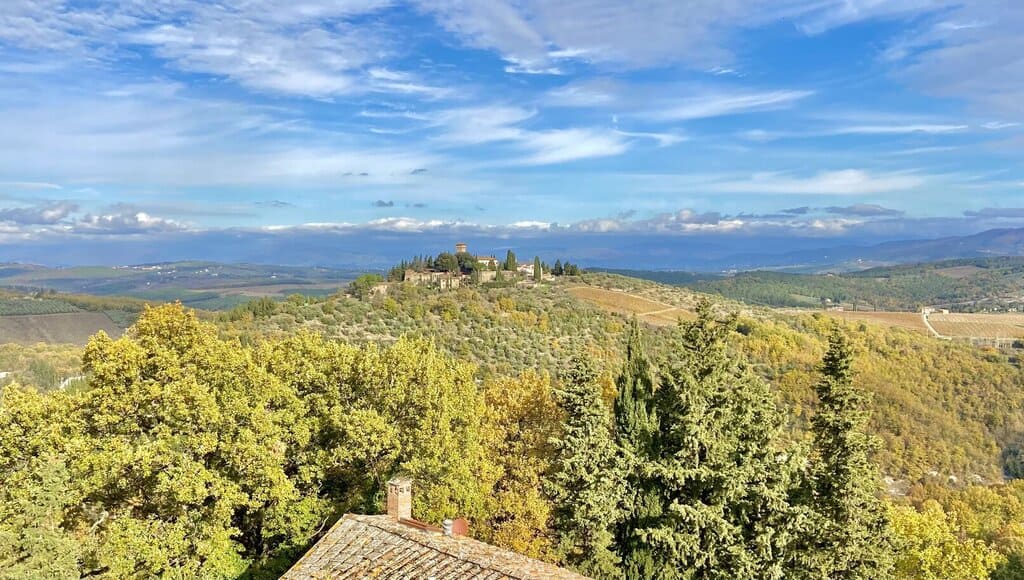
Not all wineries are castles, of course. Most look like villas in the countryside. They are all beautiful though. It’s hard to find a not-so-nice-looking winery in Tuscany. Anywhere you go is going to be amazing, but check out the next section for some recommendations.
The top Chianti wineries to visit
The toughest decision you will make on your trip through Chianti is which wineries to visit. There are so many, and they are all similar, making similar wine. So how to decide? Well, that’s a tough question. I asked around my Italian friends and the hotels I stayed at in Florence and Siena and came up with the following list.
- Castello di Verrazzano: This was the castle winery I chose to visit and it did not disappoint. It’s a sprawling, absolutely gorgeous property with fantastic wine and food. I did the basic tour, which was 24 euros, but they also offer more in-depth tasting tours with lunch.
- Poggio Amorelli: The other winery I visited. Not a castle, but a lovely setting on a hill overlooking Tuscany. I had lunch here and it included essentially unlimited wine. As soon as the server saw an empty glass it was refilled. 50 euros for lunch and wine tasting.
- Azienda Agricola Campocorto: If you want a small, family-run experience.
- Fattoria di Montemaggio: I almost booked this one but chose Verrazzano instead.
- Castello di Bossi
- Il Molino di Grace
- Azienda Agricola Montechiaro di Alessandro Griccioli
There are of course many more options but these are some to think about. If you don’t want to think too hard about it though, you should consider doing an organized wine tour where they pick you up and drive you around to the Chianti wineries. You can view and book a great Chianti wine tour here!.
Another great option for visiting some Chianti region wineries is an e-bike tour. You can book an awesome 7-hour e-bike tour to the vineyards through Manawa. You’ll meet your guide just north of Siena and be on your way to an epic day of biking around the vineyards and tasting amazing wine!

Tuscan Villages
When you think of charming medieval villages, it’s hard not to think of Tuscany. Ancient houses built from sand-colored stone with cobblestone streets. It’s what Tuscan dreams are made of.
There are dozens of charming villages across the region and it is impossible to cover them all here. I’ll just give a quick rundown of my Top 5. Note that this does not include larger towns like San Gimignano, which is worth a visit too.
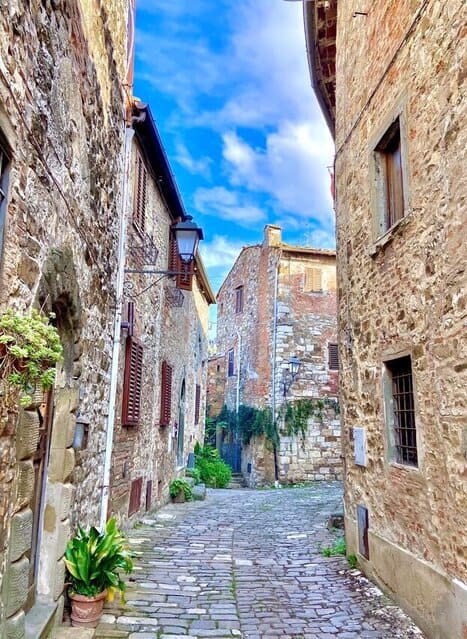

- Volterra: On the larger side for Tuscan villages but a must-see. Perched atop a hill it’s a great place to watch the sunset.
- Monteriggioni: A tiny walled village that is easy to see in less than an hour. Absolutely amazing, one of the best medieval villages in Italy, along with Casertavecchia.
- Chiusdino: I didn’t make it here but saw it from the Abbey of San Galgano and its photos look superb.
- Motefioralle: A little village high on a hill in Chianti with just a few adorable streets. Well worth a stop for 15 minutes or so
- Lucchio: This village is actually northwest of Florence and I haven’t been there. But one look at photos of the houses built on the steep mountain and you’ll be adding it to your itinerary in no time.
- Lucca: While more of a city than a village, Lucca is worth going a bit out of your way for. The old city is surrounded by a beautiful medieval wall, but unlike Siena this one you can actually walk on.


The Abbey of San Galgano
One of the most spectacular ruins of a medieval cathedral in the world lies about 45 minutes southwest of Siena. While not in the Chianti region, I can’t make a post about Siena without mentioning the Abbey of San Galgano. This 13th century church in the middle of nowhere was left in ruins for 600 years before being partially restored in the 20th century. The roof was looted for building materials in the 18th century and today the abbey is in pretty good shape, other than completely missing a roof.
How to visit the Abbey of San Galgano
The ancient abbey is open year round from 10-5:30 and admission costs 5 euros as of 2021. There isn’t a whole lot to do. You basically just explore the ruins from the inside. It’s possible to walk around the exterior of the church if you don’t want to pay to go inside. There is a large parking lot, as the only way to get there is by car.
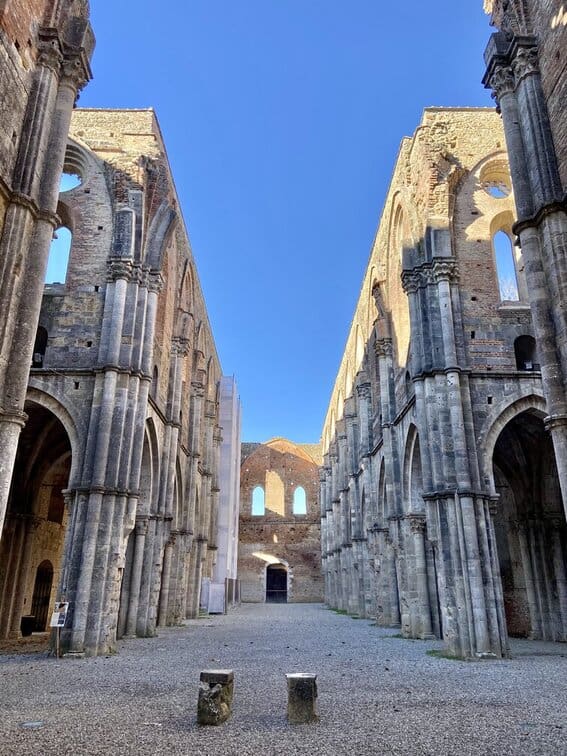
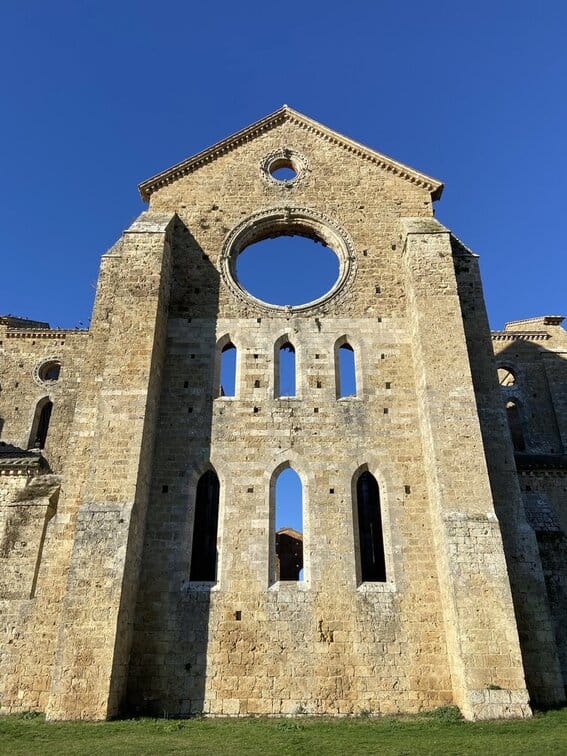
The Sword in the Stone
Just up a small hill from the abbey sits the Montesiepi Chapel, a small rotunda actually built before the abbey and still intact. At the middle of the rotunda you will find a sword protruding from a stone.
Now this sword really has nothing to do with the famous novel and Disney movie “Sword in the Stone.” That was set in medieval Great Britain and is completely fictional. But nonetheless there is an actual sword in a stone here, said to be driven in by Galgano himself.
Nobody knows exactly how it got there, but the iron of the sword has been dated back to the 1100s and seems legit. So if you’re curious to see the actual sword in the stone in real life don’t skip the Montesiepi Chapel!
Chianti Region Wineries – Frequently Asked Questions
What is the Chianti region known for?
The Chianti region is famous for its unique wine, Chianti Classico, as well as rolling hills of vineyards and medieval villages. Chianti Classico only comes from a small region of Chianti and must be composed of at least 80% Sangiovese grapes.
What is the oldest winery in Chianti?
The oldest winery in the Chianti region is the Ricasoli Winery, which traces back to 1141. The winery is family-run and it’s possible – though not cheap – to tour their castle and gardens.
How many wineries are there in Chianti?
There are over 5000 individual wineries in the Chianti region of Italy. These range from wineries that reach every country in the world to wineries that don’t ship beyond their property. You can find almost anything in Chianti when it comes to wineries.
What is the difference between Chianti and Chianti Classico?
Chianti Classico must be produced within the historical Chianti region of Italy. Chianti can be produced outside of the region. Chianti Classico is distinguished by black rooster emblem on all bottles. If it doesn’t have the black rooster, it’s not real Chianti Classico.
What is the largest town in Chianti?
Greve in Chianti is the largest town in Chianti. With a modest population of 14,000 people, it’s still a small town.
Final Word
Italy is full of amazing places and you can never go wrong in a country so rich in history and culture. Given that, I was surprised at just how impressed I was with Siena and the Chianti region. I would go back in a heartbeat. For now I’ll just have to settle for drinking Chianti Classico looking at photos of the ancient city and villages. A trip to this part of Italy will not disappoint!


4 comments
[…] stunning city of Siena is located right in the heart of Tuscany and makes for a good place to base yourself. Between Siena […]
[…] reminds you of the Italian villages in Tuscany or Dubrovnik in Croatia. Valletta itself is a UNESCO World heritage Web site, and it doesn’t take […]
[…] about two hours north of Rome and two hours south of Siena in the province of Viterbo, Civita sits atop an eroding hill overlooking the Italian countryside. […]
[…] about two hours north of Rome and two hours south of Siena in the province of Viterbo, Civita sits atop an eroding hill overlooking the Italian countryside. […]